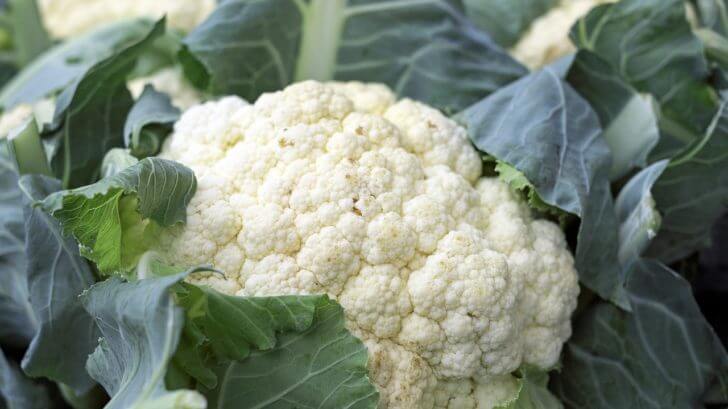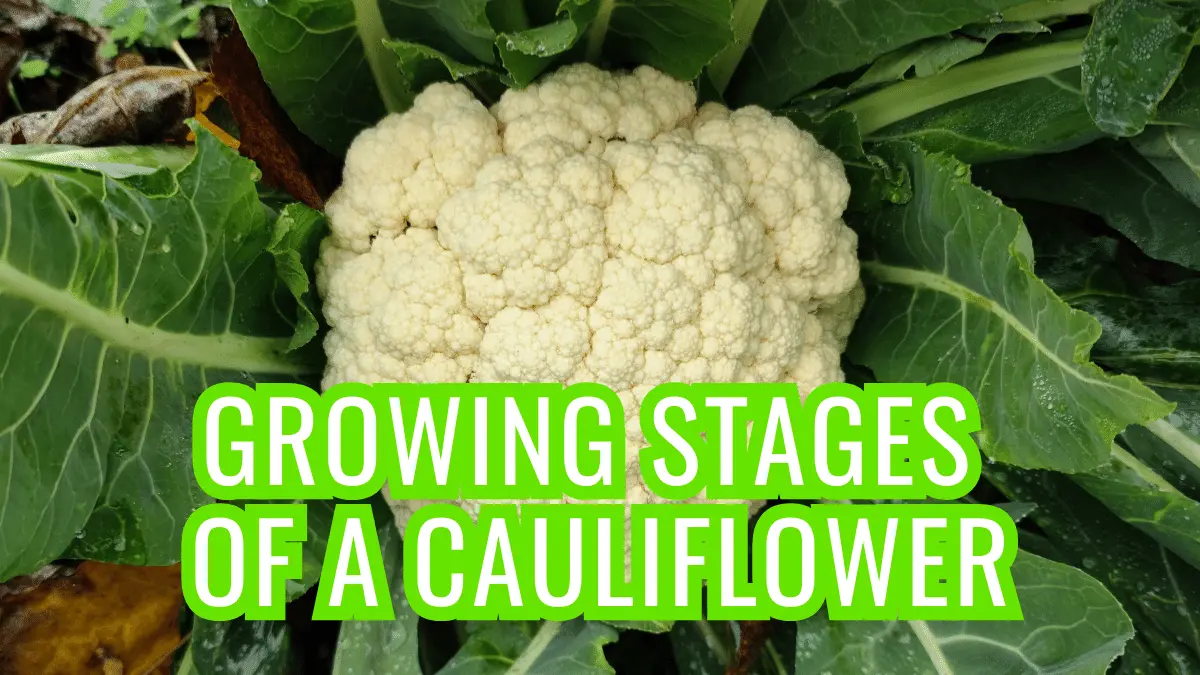We use affiliate links to run our site. When you buy through links on our site, we may earn an affiliate commission, without any added cost to you. Learn more
Gardening can be a fun and rewarding experience, but it also takes knowledge and skill. If you’re interested in growing your own cauliflower, understanding the full plant growth cycle is essential for successfully achieving this goal.
Cauliflower is a cool-season crop that is quite popular thanks to its crunchy texture and mild flavor. However, growing cauliflower successfully requires knowing the different growth stages and tending to the plant’s needs at each phase.
In this complete guide, we will walk through the full cauliflower plant lifecycle from seed to harvest. The post will provide an in-depth view of how to identify sprouts when to expect head formation, steps to prevent bolting, and methods to harvest heads.
Table of Contents
Growing Stages of Cauliflower
Stage 1 – The Seeds
Cauliflower growth begins with seeds. There are many cauliflower seed varieties to choose from, including hybrids and heirlooms in white, orange, green, and purple.
When selecting seeds, choose an early-maturing variety if you want to harvest cauliflowers sooner. Late-maturing varieties produce larger heads but require a longer growing season.
Planting Tips for Growing Healthy Cauliflower Plants
- Direct sow seeds 1⁄4-1⁄2 inch deep and 12-24 inches apart. Or start seeds indoors 4-5 weeks before the last spring frost.
- The ideal soil temperature for germination is 70-85°F.
- Seeds need consistent moisture to sprout. Water gently to avoid washing away seeds.
- Thin seedlings to 12-24 inches apart when they have 3-4 true leaves.
- Plant cauliflower in full sun (at least 6 hours per day).
Stage 2 – Germination
If seeds are planted directly in the garden, they will germinate in 7-12 days when soil temperatures reach at least 50°F.
Indoor-started seeds may emerge in just 3-5 days. Look for the first seed leaves (cotyledons) poking up through the soil.
First True Leaves:
After the cotyledons unfurl, the first set of true serrated cauliflower leaves will appear. These early leaves look like miniature versions of mature cauliflower foliage.
Proper spacing at this point helps avoid overcrowded, stressed plants. Thin seedlings if they are less than 12 inches apart.
Third True Leaves:
Within 2-3 weeks of sowing, third true leaves will emerge. These leaves may display a grayish tint. Now is the time to provide consistent water and nutrition. Options include:
- Liquid fertilizer – fish emulsion, compost tea
- Granular fertilizer – 10-10-10 or 5-10-10 blends
- Compost and manure worked into the soil
- Mulch around plants for moisture retention
Stage 3 – Seedling:
Over the next 3-4 weeks the cauliflower seedling will grow larger, develop more leaves, and strengthen its root system. A few important care tips at this stage:
What to Look Out For at the Seedling Stage
- Leggy, weak growth – This indicates plants need more sunlight.
- Wilting leaves – Increase water if the soil is dry 1” below the surface.
- Purplish leaves – A sign plants need more nitrogen fertilizer.
- Insect pests – Cabbage worms and aphids can attack. Use organic pest control early.
- Tip burn – Prevent this calcium deficiency with lime or gypsum.
Stage 4 – Foliage Growth
During the next 4-6 weeks the cauliflower plant transitions from a seedling to actively growing foliage. The leaves completely cover the developing head.
Nurturing Your Cauliflower Through its Vegetative Stage
- Weed control is critical now to reduce competition for nutrients and water. Mulch also smothers weeds.
- Drought stress affects head development and size. Water 1-2 inches per week.
- Side dress with nitrogen fertilizer if foliage looks too pale.
- Cage or tie leaves to shade curds once heads become visible. This prevents discoloration from sun exposure.
Stage 5 – Growth of the Cauliflower Head

Between 50-100 days after planting, tight, compact curds will begin enlarging within the leaves. Avoid any disruption to the foliage surrounding the curd at this crucial stage.
Gently move leaves aside periodically to inspect the head size. When heads are roughly 4-6 inches across, they are often ready for harvesting. But variety-specific maturity dates are the best gauge.
Early-maturing cauliflowers may reach this in under 2 months. Late varieties take 100 days or longer to form harvestable curds.
Stage 6 – Bolting / Flowering
Once curds attain full size, the plant enters the bolting and flowering stage. Given the right cues like long sunlight exposure, the stalk rapidly elongates and flowers emerge. Exposure to frost can also trigger bolting.
At this point, the head will become loose and rice-like in texture. The flavor turns bitter. This makes the curds inedible, so it’s important to harvest before visible signs of bolting.
How to Monitor and Support Cauliflower During Flowering and Harvesting
- Check maturity dates and harvest once heads reach the ideal size. This prevents losses from bolting.
- Cut heads with 4-6 inches of stem attached. Use a sharp knife to avoid damage.
- Support plants after cutting the main head. Side shoots may develop smaller curds.
- Provide sufficient water post-harvest so plants can still produce side shoots.
Stage 7 – Seed Production
If you leave the flowering head intact, it will produce seed pods. These tan, oblong pods contain dozens of small, black cauliflower seeds.
To collect seeds, allow pods to dry completely on the stems. Then break them open and separate out the seeds. Store seeds in a cool, dry place.
Stage 8 – Death/ Maturation Stage:
Sadly, all good things must come to an end. Even with the best care, cauliflower is a cool-weather crop that declines once temperatures rise.
Expect the plant to completely die back over the summer. Pull up spent plants and compost them to improve soil for next year’s garden.
Now you know all about the life stages cauliflower goes through! Let’s recap the key points:
Simple Tips For Growing Cauliflower
- Select early or late-maturing varieties based on your climate. Sow seeds 1⁄4-1⁄2 inch deep, 12-24 inches apart.
- Thin seedlings when they have 3-4 true leaves. Transplant on an overcast day or late afternoon.
- From seedling to mature plant takes 50-100+ days depending on variety.
- Ensure consistent moisture and nutrition during germination, seedling growth, and head development.
- Shade and protect curds from the sun once they become visible. This prevents discoloration.
- Harvest mature heads when they reach 4-6 inches across before any bolting occurs. Cut with stem attached.
Conclusion:
Growing cauliflower is an activity that requires patience, diligence, and an understanding of the plant’s growth cycle. It is essential to observe the growth of your plants for signs of potential pests or maladies and to provide adequate nutrition throughout each phase of cauliflower’s life cycle.
Even when following best practices, it takes some trial and error before achieving a successful harvest. With knowledge, practice, and an eye on your cauliflower progress at all stages, you can become an experienced gardener in no time!
If you are interested in expanding your horticultural experience further—perhaps experimenting with hybrid varieties—browse more posts in this site for reliable information on various vegetable species.
Be sure to share your experiences in growing vegetables with other gardeners; together we can help secure a greener world! Take action today: Add more green space to your home environment by planting a few seeds in a container or garden plot near you!
FAQs
How Long Does It Take for Cauliflower to Head?
On average, it takes 75-100 days from seeding to harvest. But depending on variety and growing conditions, it may take as little as 50 days or as many as 110+ days. The seed variety’s stated “days to maturity” is the best indicator.
How long does it take cauliflower to flower?
Flowering and seed production begins immediately after harvest if plants are left intact. The stalk rapidly elongates, flowers emerge, and seed pods form within 7-10 days after cutting the main head.
Does cauliflower bloom more than once?
No, cauliflower is generally a one time bloomer. After the initial curd is cut, some side shoots may produce smaller heads, but the plant won’t bloom again after bolting.
In Which Month Do You Harvest Cauliflower?
Cauliflower is ready for harvest anytime from early summer through fall before the first frost. Late-maturing varieties planted in summer are harvested in fall. In mild climates, overwintered cauliflower matures in late winter/early spring.
What does cauliflower need to grow well?
Full sun
Consistent moisture
Well-draining, nutrient-rich soil
Cool temperatures
Protection from pests
Lime/gypsum to prevent tip burn
Caging or tying leaves once heads form
Amazon and the Amazon logo are trademarks of Amazon.com, Inc, or its affiliates.

Hi there! My name is Prasenjit and I’m an avid gardener and someone who has grown a passion for growing plants. From my hands-on experience, I have learned what works and what doesn’t. Here I share everything I have learned.
